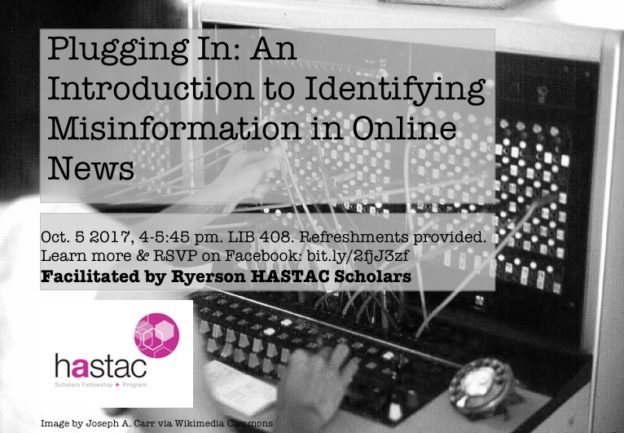Hello everyone,
On August 30th, a colleague, Alison Hedley and I ran a twitter chat concerning online news and misinformation. Although we are careful to frame the issue as a long-standing one, our goal is to continue discussion and create more space to talk about the specific ways in which online misinformation has pernicious impact on our everyday, the way we share, learn, understand and choose to communicate news through digital media and social media platforms.
As scholars, it is important to define misinformation and fake news as: 1) the omission of part of the information; 2) lies; 3) reporting information with the intention to misguide.
We start the conversation with eight questions we wanted to have our audience think about and share about. In the context of HASTAC’s commitment to pedagogy, we particularly invite instructors, professors and teachers to share their thoughts on student awareness and engagement in regard to addressing online misinformation and/or fake news and what are some strategies you have adopted to make quality education and critical intellectual growth a priority.
The questions are the following:
Q1 What constitutes misinformation in online news?
Q2 What are the components of online news literacy?
Q3 What strategies can be used to verify online news info?
Q4 How does misinformation online impact your students? Your classroom?
Q5 Have your students expressed more interest in this topic since the term “fake news” became prominent in public discourse?
Q6 Do students seem pretty online news savvy?
Q7Do students look to instructors & university resources for guidance, or to one another, or elsewhere?
Q8 How do you model online info literacies in the classroom? News literacy specifically?
Q9 How can we make online news outlets accountable for accuracy? Do you encourage students to do the same?
Twitter Chat:
During the twitter chat #HASTACmisinfo, we explored definitions of online news, and how to engage the classroom around the topic in a critical way, which we would like to hear more about. A strong point raised was in the importance of presenting information to students about why sources were classified as fake news (going through credentials) and engaging them to find their own examples. Defining reliable sources was also raised as an important part of that process.
Some other highlights were the points that came out of the twitter discussion such as, taking in consideration the emotional stakes of calling out online news, wanting to converse with librarians about their thoughts on media literacy and thinking of strategies to hold media outlets accountable.
We will be running a workshop on October 5th 2017 at Ryerson as a follow-up to our commitment to continue the conversation about online news. Visit our Facebook event page at: bit.ly/2fjJ3zf.
We encourage feedback in the comment bar below, through email (ahedley@ryerson.ca; ejabouin@ryerson.ca), twitter: @alison_hedley; @emilie_jabouin.
Please add to our resources’ list:
– Critical Algorithm Studies Reading List
– Breaking News Consumer Handbook
– Autostraddle Fake News Chart (and the original resource the article links to)
– Noam Chomsky, Media Control: The Spectacular Achievements of Propaganda, Seven Stories Press, NY, 2002
– Bergstrom and West’s course website, callingbullshit.org
– Factcheck.org, “How to Spot Fake News”
– Highlights from the history of fake news from the New York Review of Books
– Digital Polarization Initiative (started by Mike Caulfield)
Mike Caulfield’s web book, Web Literacy for Student Fact-Checkers
– Lee Skallerup’s blog about Mike Caulfield’s work
Emilie Jabouin,
HASTAC Scholar 2016-2018
Ryerson University
